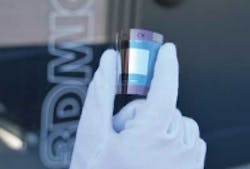3D-Micromac receives Green Photonics Award 2011 from SPIE at Photonics West
San Franciso, Calif. – 3D-Micromac, Chemnitz, Germany, was honored with the "SPIE 2011 Green Photonics Award" on January 26 at Photonics West. Tino Petsch, CEO of 3D-Micromac, received the prize for the scientific publication, “Laser processing of organic solar cells in a roll-to-roll manufacturing process." With this award, SPIE pays tribute to the research work of the company in the field of "green technologies."
An article by 3D-Micromac author Christian Scholz, "Reel-to-reel machining: Using ultra-short pulsed lasers," will appear in the March/April issue of Industrial Laser Solutions.
3D-Micromac has been successful for years in the development and commercialization of laser systems for processing of wafer-based as well as thin-film solar cells. Since early 2009, the company's engineers have been engaged in laser processing of organic photovoltaic cells (OPV). The aim is to develop and manufacture whole production lines for manufacturing of OPVs from the raw materials up to the encapsulated cell. In addition to procedures like laser structuring and laser annealing, technologies such as gravure printing, slot die coating, and the inkjet printing are used.
In contrast to conventional inorganic solar cells, an organic solar cell consists of organic compounds (carbon compounds). Advantages of these OPVs are low manufacturing costs, flexibility, transparency and easy handling. Currently, a relatively low efficiency is achieved (about 8% in the laboratory scale). Moreover, the long-term stability of organic compounds is not sufficient. Organic solar cells are ideal for usage in mobile devices and systems.
SPIE is a non-profit international society for optical engineering. SPIE organizes a number of meetings and symposiums, as well as conferences, courses and exhibitions. The organization publishes a number of refereed journals, conference proceedings, reference books, and tutorials.
